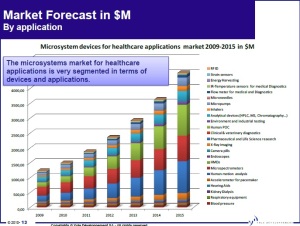Frédéric Breussin, Yole Developpement, an expert in microfluidics for diagnostics and life sciences, recently presented on MEMS devices driving healthcare applications.

According to him, microsystem technologies are changing the healthcare industry. New in-vitro diagnostic systems, new therapy strategies, genetic disease treatment, targeted and intelligent drug delivery, artificial pancreas, drug discovery processes are healthcare improvements promised to future generations.
Microsystem devices, including MEMS devices, SI based sensors, Microfluidic chips and Bio sensors find many applications in healthcare markets:
* Pharmaceutical research market ($870 billion worldwide 2010),
* In-vitro diagnostics ($57 billion worldwide 2010),
* Medical devices ($255 billion worldwide 2010), and
* Medical home care ($54 billion worldwide 2010).
Within these applications, the MEMS/microsystem technologies market for healthcare will grow from $1.4 billion in 2010 to $4.5 billion in 2015, which represents over 1 billion units per year in 2015. The largest markets are microfluidic devices and bio-sensors for diagnostic and pharmaceutical applications. However, one should keep in mind that the unit price is relatively high, and that the microfluidic market is very segmented in terms of “biological” applications and players.
Geographic distribution of the medical device market (including IVD) – 2010, is as follows: Canada – market size $6.15 billion, world share 2 percent and growth 8 percent. The USA – market size $118 billion, world share 40 percent and growth 4 percent. Brazil — market size $3.69 billion, world share 1 percent and growth 7 percent. The EU – market size $95 billion, world share 32 percent and growth 5 percent. China — market size $13.50 billion, world share 5 percent and growth 14 percent. Japan — market size $26 billion, world share 9 percent and growth 4 percent. India — market size $3.82 billion, world share 1 percent and growth 12 percent. Russia — market size $6.33 billion, world share 2 percent and growth 8 percent, respectively.
Four markets have been considered in the report — pharmaceutical, in vitro diagnostics, medical devices and medical home care. In pharmaceutical, which involves drug discovery and sales, the market size has been estimated at $870 billion for 2010 with microsystems contribution at $220 million. This market is said to be growing at 4 percent CAGR in 2009. The in vitro diagnostics market, which includes biological tests development and sales, has been estimated at $57 billion in 2010 with microsystems contribution worth $690 million. It is said to be growing at ~11 percent CAGR in 2006.
Medical devices, inclusive of medical equipment development and sales, was estimated at $295 billion in 2010, with microsystems contribution $460 million. It is growing at 6 percent CAGR. Medical home care, inclusive of prescribed medical devices and services for home care, was estimated at ~$54 billion in 2010, with microsystems contributing $44 million. It is growing at 9 percent CAGR.
In microsystem devices for pharma research, discovering and bringing one new drug to the public typically costs a pharmaceutical or biotechnology company nearly $900 million and takes an average of 10 to 12 years.
The drug discovery and drug development process is designed to ensure that only those pharmaceutical products that are both safe and effective are brought to market. Biosensor, biochip and lab on chip systems are of great interest to reduce cost and time in the drug discovery process through automation, screening and multiplexing, and reduction of sample and reagent volumes.
Among microsystem devices for IVD, biochip and microfluidic components find applications in the medical, industrial and environmental in-vitro-diagnostic applications. These provide solutions to the market requirements in terms of miniaturization, multiplexing and integration of multiple functions.
Medical applications for microsystem technologies include commercialized products, such as:
* Pressure sensors for blood pressure, respiratory or kidney dialysis monitoring.
* Accelerometers for pacemakers.
* Silicon microphones, micro-actuators and microelectrodes for hearing aids.
* Microelectrodes for cochlear implants.
* Micropumps for infusion drug delivery.
* Needle free injection devices.
* IR ear thermometers.
* Atomizers for nasal or pulmonary drug delivery.
* Ultrasound sensors for medical imaging.
* Neural stimulation for devices.
* Smart pills for imaging.
* Accelerometers for human fall detection.
* Sensors for home monitoring of elderly or diseased people.
* Microneedle for transdermal drug delivery.
* Active patches for transdermal drug delivery.
Emerging products include:
* Implanted systems for drug delivery.
* Wireless systems for patient monitoring.
* Advanced imaging devices (resolution, miniaturization).
* Sensors for computer-assisted surgery (force feedback, surgery robots).
* Smart pills for drug delivery.
* Closed-loop systems for drug delivery (theranostic).
* Miniaturized instruments combining sensors and effectors for image-guided therapy.
Market forecast
The medical market today represents 19 percent of the total MEMS market in dollars. It is expected to reach 26 percent of the market in 2016. The main MEMS device market in production volume remains the consumer market. Medical market represents less than 10 percent of the total MEMS production.
The microsystems market for healthcare applications is very segmented in terms of devices and applications (see graph).
Pradeep, thanks for this very useful insight. MEMS is certainly seeing accelerated adoption in medical devices/pharma world.
Thanks for the appreciation. Best wishes.